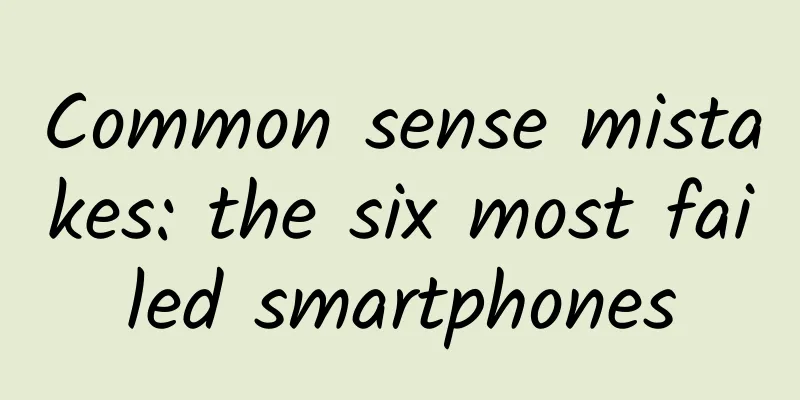Common sense mistakes: the six most failed smartphones

|
Recently, a media listed and summarized the six most failed smartphones in the past four years, namely Microsoft's Kin series, Nokia's N9, Nokia X series, HTC ChaCha/Status, HTC First, and HP Veer 4G. According to the manufacturers, they include Microsoft, HP, Nokia and HTC. Judging from the current decline of these four manufacturers in the smartphone market, although we cannot be completely sure that it is related to the failed products in the past, these failed products still reflect the common sense mistakes made by these manufacturers in the development of the smartphone industry, which is of reference significance for their future development and other manufacturers. Among the six most unsuccessful smartphones, the Kin series launched by Microsoft in May 2010 was the first to fail (this was Microsoft's first foray into smartphone hardware). In fact, when it was released, we analyzed that it had little chance of success. Of course, in addition to the high price and the positioning of young people, which are debatable reasons, the fundamental reason is the hybrid operating system used on Kin. That is, the operating system used by Kin is not Windows Phone 7, which Microsoft wanted to promote at the time, nor is it a brand new operating system, which means that it does not fully support Microsoft's Windows Phone ecosystem. More importantly, Microsoft's approach caused considerable trouble to users who chose Microsoft's smartphone ecosystem, and did not play a role in promoting Windows Phone 7. At that time, Microsoft's Windows Phone 7 was already in a state of decline and unpopularity. What was the purpose of Microsoft's move to promote Kin? The most basic thing is to promote Windows Phone 7 through its own hardware platform. Unfortunately, Microsoft did not even think this through. The Nokia N9 released in September 2011 is highly similar to the Microsoft Kin. Although Nokia's official marketing and public relations materials at the time showed that the N9 used the MeeGo 1.2 system. But in fact, a large part of the N9 used the code of the Maemo 6 system, which means that Nokia's N9 also used the so-called hybrid system like Microsoft's Kin, but the fact known to the industry is that Nokia has announced that it will abandon Maemo and switch to the MeeGo system. At the same time, there were rumors that Nokia would cooperate with Microsoft to adopt the Windows Phone system in the future. In this case, as a Nokia phone that was praised by the industry for its high-quality engineering level and luxurious craftsmanship at the time, it should have adopted MeeGo or postponed the adoption of Microsoft's Windows Phone 7 system after reaching a cooperation with Microsoft. This shows that Nokia's mobile phone strategy in 2011 was quite vague and wavering. At least its products did not fully reflect its strategy, and even ran counter to the strategy. The key is that Nokia missed the opportunity to prove to the outside world with its best hardware level (N9) that it could survive and even develop under the suppression of Apple and Google. As the saying goes, every failure makes you wiser. Unfortunately, nearly three years later, Nokia repeated the mistake of N9, releasing the Nokia X in February 2014. Not to mention that Nokia had been acquired by Microsoft at that time, it should have vigorously promoted Microsoft's Windows Phone system. Even if it didn't have the ability, it should at least not help its opponents. But Nokia did this kind of thing that hurt Microsoft and made Google happy. What is even more puzzling to the industry is that even though Nokia X uses Google's Android system, it is not native, and it promotes Microsoft's Windows Phone applications based on this platform. Not only is the system mixed here, but the applications are also mixed. Not to mention that Microsoft's withdrawal of the Nokia X is inevitable, just the fact that Nokia launched the Nokia X itself is something that is difficult to justify in terms of both reason and emotion. The same thing happened to HTC. That is, the HTC ChaCha/Status phone released in June 2011. HTC ChaCha is a deeply customized full keyboard phone launched by HTC in cooperation with social giant Facebook. It focuses on social functions and also has a customized Facebook function key on the keyboard. We will not elaborate on the reasons why HTC ChaCha failed at the time. What we don’t understand is why the original mistake was repeated two years later in 2013. In April 2013, HTC launched the so-called Facebook phone - HTC First. As a result, only about 15,000 units were sold in the first month after its launch. The initial two-year contract price given by AT&T was US$100, and then it was reduced to US$1, which was almost zero yuan. Even so, AT&T couldn’t even sell all the inventory and had to return it to HTC. Finally, we want to talk about the Veer 4G mobile phone released by HP in May 2011. Here we also examine the product itself in detail, but we just want to say that shortly after the release of this mobile phone, HP announced that it would abandon the WebOS system that it acquired from the merger of Palm. So can we conclude that before the release of the Veer 4G mobile phone, HP had already considered abandoning WebOS, at least wavering in its future strategy for smartphones, and how competitive can the mobile phone products released under such wavering conditions be? How much meticulous work has been done? I believe that even without us saying it, the industry is very clear. From the analysis of the six most unsuccessful mobile phones in the past four years, it is not difficult to find that these failed products are all key periods for the relevant companies in the smartphone market and their own development, but common sense mistakes (such as not knowing what to do, repeating past mistakes, etc.) not only led to the failure of these products, but more importantly, made these companies lose the chance to turn around and even survive. Microsoft and HTC are still struggling, Nokia was acquired, and HP almost withdrew from the smartphone market. This also warns other companies that when launching new products, especially when the industry or themselves are changing or facing a turning point, they should think twice before acting, at least not violate business common sense. As a winner of Toutiao's Qingyun Plan and Baijiahao's Bai+ Plan, the 2019 Baidu Digital Author of the Year, the Baijiahao's Most Popular Author in the Technology Field, the 2019 Sogou Technology and Culture Author, and the 2021 Baijiahao Quarterly Influential Creator, he has won many awards, including the 2013 Sohu Best Industry Media Person, the 2015 China New Media Entrepreneurship Competition Beijing Third Place, the 2015 Guangmang Experience Award, the 2015 China New Media Entrepreneurship Competition Finals Third Place, and the 2018 Baidu Dynamic Annual Powerful Celebrity. |
<<: Meizu MX4 is the most sincere imitator of Apple
>>: Fingerprint recognition explosion: Who sets the rules of the game?
Recommend
Romantic fireflies are actually very cruel
The silver candle lights up the cold painting scr...
Do you really know how to leverage brand marketing?
Many brands are accustomed to using the marketing...
Why IT tycoons were easily believed in the "drug abuse rumors"
It is indeed not rational for the public to belie...
Why is "Chang'an 30,000 Miles" so popular? Using poetry to promote the craze for Chinese studies! Have you memorized a poem today?
Recently, "Chang'an 30,000 Miles" h...
WeChat mini program name registration, how to choose a mini program name?
1. Mini Program Name Setting 1. The name of the m...
Holiday Tips: A summary of the first batch of user source methods for 24 apps!
Regarding the promotion of Apps, there are a lot ...
What is a good product and how can a good product make money for a company?
Any business model and product that is not aimed ...
How do advertisers choose “KOL” to promote their products?
Today, the self-media industry is developing at a...
Super high efficiency technique, make your life 10 times more efficient
【Super Efficiency Technique】 Make your life 10 ti...
How to increase user repurchase rate? Take the fresh food e-commerce APP as an example
The fresh food e-commerce industry continues to r...
We found the most beautiful lakes in the world! Some of them can be seen in China
Lakes are peaceful, clear and refreshing. But in ...
Dr. Mo: The content media industry is in a new dilemma of transformation
In the era of mobile Internet, the content and me...
Surface temperature 42 degrees Celsius, another candidate for future home | Expo Daily
Surface temperature 42 degrees Celsius, Future Ho...
Japanese movie "Rurouni Kenshin" live-action version of the four-part series HD Japanese subtitles (2012-2021) collection Baidu cloud download
Japanese movie "Rurouni Kenshin" live-a...
Are fluffy powder and wash-free spray the magic weapon to save oily-haired girls? Doctor: Don't use them, you'll go bald
"I found that the only thing that I have not...









